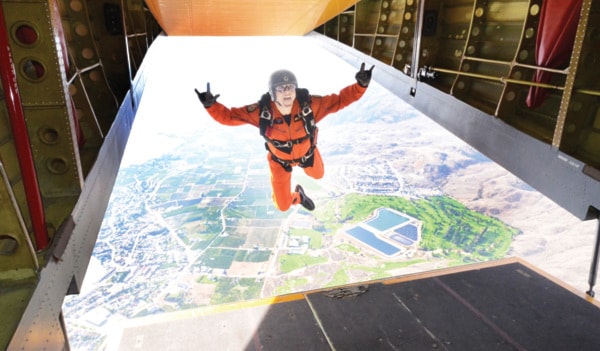A small plane with three people on board is overdue at its destination after taking off from Kelowna International Airport eight hours ago.
With no communications since then it is believed to have crashed somewhere in the rugged mountains to the southwest.
At this stage, the Joint Rescue Co-ordination Centre in Victoria has swung military aircraft into action.
That is the scenario facing the crew of the 19 Wing Comox 442 Squadron Buffalo aircraft as they take off from Penticton Regional Airport shortly after dawn on a recent training exercise mission.
On board the bright yellow and red, twin-engine workhorse — now nearly a half-century old — this day are nine souls.
That includes the two pilots, navigator, flight engineer and three search and rescue technicians, better known in the business as SAR techs.
Pilot and first officer Capt. Steve Kind is in charge on this flight as part of his training to upgrade to aircraft captain.
Although based on the coast, he points out 442 Squadron is regularly tasked to incidents in the Interior, which is why these exercises are critical.
“The mountains can be very challenging and those challenges come down mainly to weather conditions,” he said while waiting to leave. “Here you’re dealing with the different winds, and if the clouds are low, can you go down into the valleys because you have to have a way out.
“It can sneak up on you and that’s why we’re here today, to get good at it so when that pager goes off at 11 o’clock at night you know what you’re going into.”
Like most military aircraft, there are no luxuries, rescue gear ranging from inflatable boats to toboggans and parachutes are packed precisely along plane’s starboard side.
There are a few bench seats and rotating stools where spotters sometimes sit for hours looking out the large convex windows for the tiniest glint of metal in the dense forests below.
Safety lines and harnesses are attached to clips and rings throughout the plane
The movements of the crew in the crowded, narrow confines are more like a choreographed dance routine as preparations are made to drop the SAR techs by parachute to the scene.
In the background over the headphones are the voices of the men as they communicate technical data and the occasional joke before the real job begins.
Because this is a training exercise, part of the work includes building the camaraderie aspect of the team which is crucial in an actual event.
The small airstrip on the outside of Osoyoos was chosen as the “crash” site for this simulation.
While the accident is fictional, what the crew and SAR techs are doing is very real and everyone must precisely know their roles.
That’s because jumping out of the rear hatch of the Buffalo at an altitude of just over 4,000 feet, there is little room for error.
In this case, two of the SAR techs, leader Kaulin Damron and George Beatteay, are using the static-line deployment where the parachutes open automatically as they leave the aircraft, and Nathan King will do a brief free fall before pulling the rip cord.
For safety reasons, the static-line method is the only one used in an actual mission.
Once on the ground, the three men quickly pack up their chutes and retrieve the gear packages which contain medical and other supplies they dropped earlier.
Pilots Kind and Dan Faux then land the aircraft on the short strip of asphalt, which also serves as the community drag strip on some Sunday afternoons.
Unlike most of the regular missions, the weather is bright and sunny, the only hint of a problem are the increasing crosswinds as the ground heats up.
The concern is evident in the voices of the pilots, and the ultimate decision is a full-power takeoff.
This particular aircraft is designated as a STOL (short take off and landing) for good reason, and why having the seat-belt securely fastened is a necessity.
Once safely in the air, crew members quickly move to the windows to check the engines, and with everything running smoothly, it’s back to Penticton and a debriefing on the afternoon’s exercise.
That involves reviewing procedures, looking for ways to correct any problems or improve procedures, because from this exercise the success of the next actual emergency — and more importantly, lives — may depend on it.
See Wednesday’s Western News for more on search and rescue operations.

